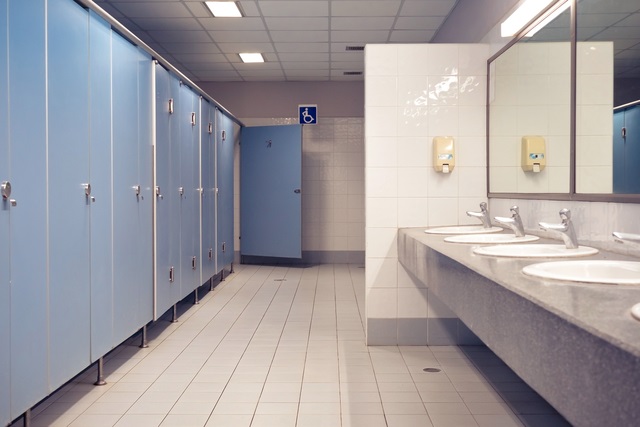A well-maintained restroom is essential for providing a positive experience for employees, customers, and visitors. However, unpleasant odors can often plague these spaces, leaving a negative impression on users. Understanding the root causes of commercial restroom odors is crucial for facility managers and business owners to maintain a pleasant and inviting environment.
Here are six of the most common factors behind commercial restroom odors as well as suggestions on how to address them.
- Poor Ventilation and Air Circulation – One of the primary causes of unpleasant odors in commercial restrooms is inadequate ventilation and poor air circulation. Insufficient airflow allows odors to linger and accumulate over time. A poorly designed or malfunctioning ventilation system fails to remove foul-smelling gases, leading to persistent and pervasive smells. Insufficient ventilation can result in the buildup of humidity, which promotes the growth of bacteria and mold, further exacerbating the odor problem. To combat this, be sure that ventilation systems are properly installed and capable of effectively exchanging air within the restroom. And regular maintenance and cleaning of the exhaust fans and air ducts is absolutely necessary. There are also odor-neutralizing systems that can help maintain a fresh-smelling restroom environment.
- Lack of Regular Cleaning – In busy commercial settings, regular cleaning and maintenance are key to preventing restroom odors. Restrooms are high-traffic areas which are prone to various sources of contamination, including urine, feces, and other bodily fluids. Neglected urinals, toilets, floors, and drains can harbor odor-causing bacteria and organic matter. When not promptly and thoroughly cleaned, these organic materials decompose, releasing foul-smelling gases and offensive odors. To combat this issue, establishing a regular cleaning schedule is crucial. Equally important is using proper cleaning techniques and cleaning agents. Restroom floors, walls, and fixtures must be regularly cleaned, sanitized and disinfected. Special attention should be given to toilets, urinals, and sinks, as they are common breeding grounds for odor-causing bacteria. The floors surrounding the toilets and urinals are another potential problem area.
- Plumbing Issues – Problems within the plumbing system can contribute significantly to commercial restroom odors. Clogged or slow-draining pipes can lead to stagnant water, fostering the growth of bacteria and allowing foul odors. Damaged or blocked pipes, leaky wax seals, wobbly toilet, or faulty traps can allow sewage gases to escape, leading to unpleasant smells. Additionally, sinks and floor drains have water traps which are designed to prevent foul odors from entering the restroom. However, when these traps dry out due to infrequent use or plumbing issues, sewer gases can seep into the restroom. Of course, call a professional plumber to address any issues promptly. Regular maintenance of plumbing systems and the use of enzymatic cleaners can help eliminate odor-causing issues related to drainage and plumbing.
- Insufficient Waste Management – Improper waste management practices can contribute to foul odors in commercial restrooms. Overflowing trash bins and lack of waste disposal containers can result in the buildup of organic waste. As this waste decomposes, it emits unpleasant odors. Having sufficient waste bins, with regular emptying and proper disposal of waste, plus using trash liners will help minimize offensive smells. Provide separate disposal containers for feminine hygiene products to prevent odor buildup and improve overall restroom cleanliness. Be sue to use bags in these containers and sanitize regularly.
- Absence of Hand Hygiene Products – Inadequate access to hand hygiene products can lead to poor restroom hygiene, contributing to unpleasant odors. When individuals do not have access to soap, hand sanitizers, or paper towels, they may not effectively clean their hands after using the restroom. This can result in the spread of bacteria and unpleasant smells. Be sure that restrooms are well-stocked with hand hygiene products promotes cleanliness and to help combat restroom odors.
- Floor Grout – Germs trapped in the grout may be contributing to the odor problem. To tackle the problem, start by thoroughly cleaning the grout lines using a grout cleaner and floor machine. This will remove any dirt, grime, or mold that may be causing the odor. After cleaning the grout, consider applying a grout sealer to create a protective barrier. This will help prevent moisture, bacteria, and odors from penetrating the grout in the future. Address any underlying issues such as leaks, water damage, or inadequate ventilation. In addition to cleaning the grout, perform a thorough deep cleaning of the entire restroom. Pay special attention to areas that are prone to odor, such as toilets, urinals, sinks, and floor drains. Use appropriate cleaning products and disinfectants to eliminate bacteria and remove any lingering odors.
Commercial restroom odors can significantly impact the overall experience of visitors, employees and customers and reflect poorly on the business. By understanding the causes behind these odors, facility managers and business owners can take appropriate measures to address and eliminate them. Implementing proper maintenance, cleaning protocols, and ensuring the availability of essential restroom supplies are crucial steps toward preventing and eliminating unpleasant odors in commercial restrooms. And maintaining clean and odor-free restrooms will enhance the reputation of your business and contribute to positive user experiences.


